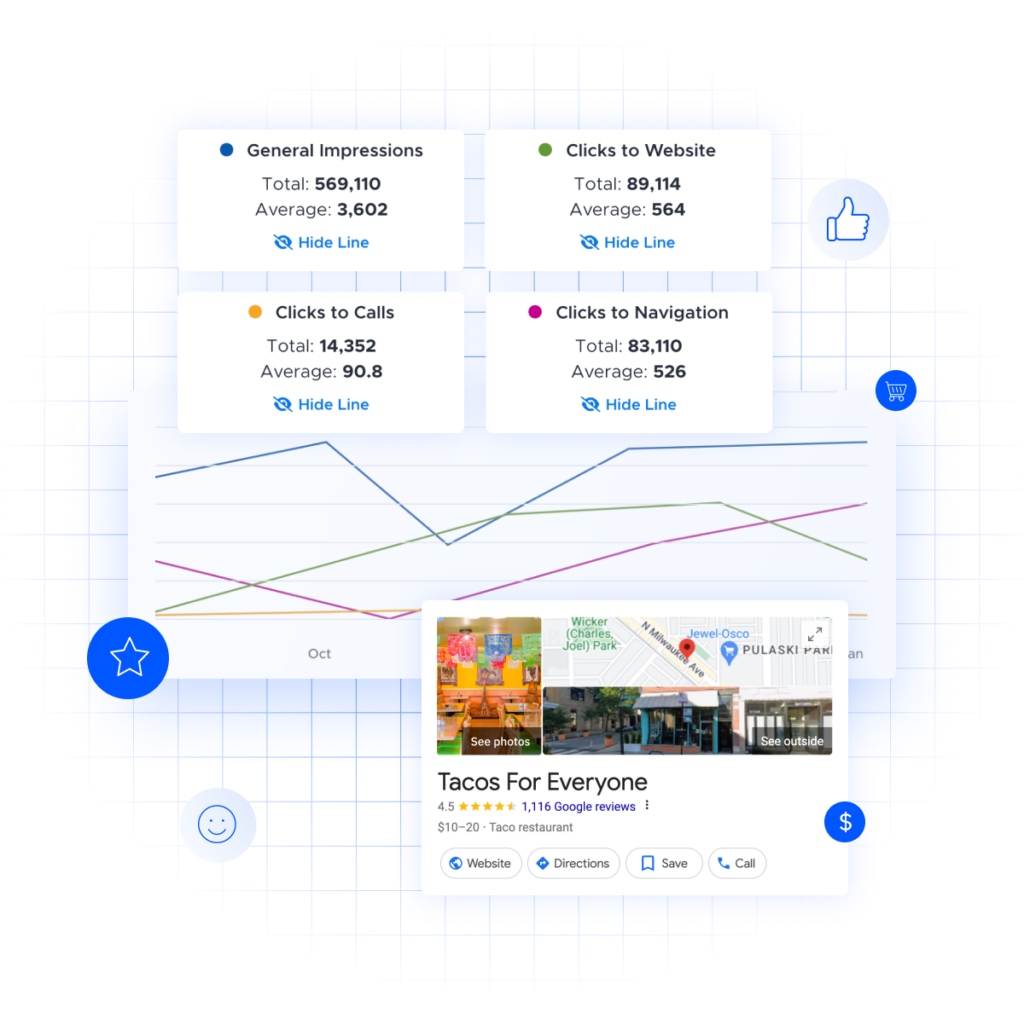Local SEO: Tips & Strategies to Get Discovered
Local SEO is the process of optimizing a business's online presence to increase its visibility in localized search results. Improving local SEO will improve traffic, acquisition, and growth.
Did you know that 46% of all internet searches have local intent? In order to capitalize on this, your business needs to be actively working on your local SEO. Local search engine optimization (SEO) is an effective strategy for driving traffic and revenue to businesses of all sizes, not just smaller local businesses. Local SEO is one of the most important factors in how your business ranks in Google Search, Maps, and more.
When executed effectively, it enables your business to attract customers organically, bypassing the need for hefty investments in traditional advertising.
What is Local SEO?
Local SEO (Search Engine Optimization) is the practice of optimizing your online presence to attract more business from relevant local searches on search engines like Google. It involves various strategies to improve your website’s visibility in local search results, making it easier for potential customers in your area to find your business.

Why is Local SEO Important?
Local SEO is one of the most important factors for driving traffic to your business. As a matter of fact, 50% of smartphone users visited a business within a day of their local search. So it doesn’t matter if you are a local business, or have hundreds of locations across the country, capitalizing on local SEO is key to standing out from your competitors and driving business success. Ultimately, investing in local SEO equips you with the tools and strategies needed to enhance your online visibility, attract relevant traffic, and drive tangible business results, regardless of your business’s size or geographical footprint.
What is an Example of Local SEO?
An example of local SEO in action is when someone searches for a specific service or product with a location-based query, such as “plumber near me” or “coffee shop in Dallas.” In response, search engines like Google display a list of relevant businesses that match the user’s query and are located in or near the specified area.
These search results are influenced by various local SEO factors, including the business’s proximity to the user’s location, the relevance of the business to the search query, and the prominence of the business’s online presence. By optimizing their websites, Google My Business listings, and other online profiles for local search, businesses can increase their chances of appearing in these local search results and attracting nearby customers.
How Does Local SEO Work?
When it comes to SEO and local SEO, there is not an exact list of everything you need to do to rank in the top positions. There is, however, a set of practices that organizations can follow in order to improve the rankings of their pages. There is a set of best practices for standard SEO, and a set of best practices for local SEO.
When it comes to local SEO, the ranking factors are more personal to your business. These factors include:
- A claimed and verified Google Business Profile
- Consistent and accurate business information such as name, address, and phone number. Often referred to as NAP
- High-quality images and videos to your Google Business Profile
- Local content that caters towards local interests, events, and news
- Positive sentiments in customer reviews
While this is not an exhaustive list, this gives you an idea of some of the most important local SEO ranking factors. To imagine what these look like in action, imagine a local bakery wants to improve their local SEO rankings so they can get more organic traffic to their business.
The business owner would claim and verify their Google Business Profile, and then complete the setup by inputting the proper NAP information as well as high-quality images of the bakery. The business owner would then create localized content such as blog posts about upcoming local events where they will be showcasing their products. Finally, the business owner would ask satisfied customers to leave a positive review, so that future prospective customers can see the positive experience that others have had.
How Long Does a Local SEO Strategy Take?
The timeline for seeing results from local SEO efforts can vary depending on various factors, including the competitiveness of your industry, the quality of your optimization efforts, and the specific strategies you’re implementing. Generally, you may start seeing improvements in local search rankings within a few weeks to several months.
For businesses in less competitive industries or smaller geographic areas, you may see results sooner, often within a few weeks of implementing local SEO strategies. This could include improvements in local search rankings, increased website traffic, and more visibility in local search results.
However, for businesses in highly competitive industries or larger geographic areas, it may take longer to see significant results from local SEO efforts. In these cases, it may take several months of consistent optimization, content creation, citation building, and other strategies to see noticeable improvements in local search rankings and online visibility.
It’s important to note that local SEO is an ongoing process that requires continuous monitoring, adjustment, and optimization. While you may start seeing initial results within a few weeks or months, the full benefits of local SEO often accrue over time as you continue to build your online presence, attract more local customers, and establish your business as a trusted authority in your community.
Local SEO Tips & Strategies
While the basic local SEO tips such as an optimized Google Business Profile, local content, and asking for reviews have already been covered, there are certain strategies you can implement that will capitalize on those tips to help you succeed.
Local Content Marketing Strategy
Local content marketing involves creating and promoting content that specifically targets and resonates with your local audience. This strategy aims to establish your business as a valuable resource within the community while also improving your visibility in local search results. Here’s how to implement a local content marketing strategy effectively:
1. Understand Your Local Audience
- Start by researching your local community to understand their interests, needs, and preferences.
- Identify common pain points, questions, or topics of interest that your audience is searching for online.
2. Create Localized Content
- Develop content ideas that are relevant to your local audience, such as guides to local attractions, events, or hidden gems in your area.
- Use Google Posts to share updates, promote special offers, and announce events.
- Incorporate local keywords naturally into your content to improve its visibility in local search results.
- Use storytelling and personal anecdotes to make your content relatable and engaging for local readers.
3. Promote Your Content Locally
- Share your content on local social media channels, community forums, and neighborhood groups to increase its visibility within the community.
- Collaborate with other local businesses or organizations to cross-promote each other’s content and reach a broader audience.
- Consider sponsoring local events or community initiatives that align with your brand values and target audience to increase exposure for your content.
4. Engage with Your Audience
- Monitor comments, shares, and feedback on your content and respond promptly and thoughtfully to engage with your audience.
- Encourage user-generated content by hosting contests, challenges, or events that encourage your audience to share their experiences and stories related to your business or community.
- Incorporate feedback and suggestions from your audience into future content ideas to ensure that your content remains relevant and valuable to your local community. This will also encourage from the google local guide program to interact with your business.
5. Track and Measure Results
- Use analytics tools to track the performance of your local content marketing efforts, including website traffic, engagement metrics, and conversions.
- Monitor changes in local search rankings for targeted keywords related to your content to assess its impact on your overall local SEO strategy.
- Adjust your content marketing strategy based on the insights gained from tracking and measuring results to optimize your efforts and drive continued success.
Local Link Building Strategy
Local link building involves acquiring backlinks from relevant and authoritative websites within your local community. These backlinks not only improve your website’s authority and credibility but also signal to search engines that your business is highly relevant to local search queries.
1. Identify Local Link Opportunities
- Research local businesses, organizations, and community websites that are relevant to your industry or target audience.
- Look for opportunities to collaborate or contribute content that could earn you backlinks, such as guest blogging, sponsoring events, or participating in local charity initiatives.
2. Create Compelling Linkable Assets
- Develop high-quality, informative, and shareable content that other websites in your community would want to link to.
- Examples of linkable assets include in-depth guides, infographics, case studies, or local resource directories that provide value to your audience and demonstrate your expertise in your industry.
3. Reach Out to Local Websites
- Craft personalized outreach emails to local websites, introducing yourself and your business, and explaining how your content or expertise could benefit their audience.
- Be polite, concise, and specific about what you’re offering and why it would be valuable to their readers or followers.
- Follow up with a friendly reminder if you don’t hear back initially, but avoid being pushy or overly aggressive in your follow-up approach.
4. Build Relationships with Local Influencers
- Identify local influencers, bloggers, or journalists who cover topics relevant to your business or industry.
- Engage with them on social media, comment on their blog posts, and share their content to start building a relationship and establishing trust.
- Once you’ve built rapport, pitch them your content or expertise as a valuable resource for their audience, and ask if they would consider linking to it or featuring it on their platform.
5. Monitor and Maintain Your Backlink Profile
- Keep track of the backlinks you’ve earned from local websites and monitor their status regularly.
- Respond promptly to any requests for link removal or changes to ensure that your backlink profile remains healthy and free from spammy or low-quality links.
- Continuously seek out new link opportunities and update your outreach efforts to reflect changes in your industry or local community.
While this is not a full list of every available local SEO strategy, this gives you an insight into what more complex local SEO techniques may look like, and how you can implement them for your business.
Features to Look for in Local SEO Software
When selecting a local SEO software for your business, there are many different features available. But, it is important to choose a software that directly aligns with your business goals. Here are some common local SEO features to consider:
- Local Business Listing Management: Software that helps you manage your business listings on local directories, review sites, and other online platforms to ensure your business information is accurate and up-to-date.
- Streamline Google Posts: Managing Google Posts across multiple locations can be challenging. Look for a solution that lets you seamlessly create and manage Google Posts in one centralized platform while also handling your local business listings.
- Review Monitoring and Management: Tools that enable you to monitor and manage customer reviews across multiple review sites, allowing you to respond promptly and maintain a positive online reputation.
- Geotargeting Capabilities: Features that allow you to target specific geographic areas with your SEO efforts, such as creating location-specific landing pages or targeting ads to users in specific locations.
- Local Rank Tracking: Tools that track your local search rankings for target keywords and provide insights into your performance compared to competitors in your area.
- Reporting and Analytics: Features that provide comprehensive reports and analytics on your local SEO performance, including metrics such as visibility, traffic, conversions, and ROI.
What is the Difference Between SEO and Local SEO?
The main difference between SEO and local SEO lies in their target audience and geographic focus. While both SEO and Local SEO aim to improve a website’s visibility in search engine results, SEO targets a broader audience on a national or global scale, while Local SEO focuses on attracting customers from specific geographic areas. Here are some other key differences between the two:
SEO (Search Engine Optimization)
- SEO focuses on optimizing a website’s visibility and rankings in search engine results pages (SERPs) on a broader scale, typically targeting a global or national audience.
- The goal of SEO is to improve the website’s overall search engine visibility and attract organic traffic from users searching for relevant keywords, regardless of their location.
- SEO strategies include optimizing website content, improving site structure and navigation, earning backlinks from authoritative websites, and enhancing user experience to increase rankings in search results.
Local SEO
- Local SEO, on the other hand, is specifically geared toward optimizing a business’s online presence to attract more customers from local searches within a specific geographic area.
- The primary focus of local SEO is to ensure that a business appears prominently in local search results when users search for products or services in their vicinity.
- Local SEO strategies include optimizing the Google My Business listing, creating locally relevant content, building citations on online directories, managing online reviews, and targeting keywords with local intent.
- The target audience for local SEO is local consumers who are actively searching for nearby businesses, making it ideal for brick-and-mortar stores, service-based businesses, and businesses with physical locations.
What Does Local SEO Have to Do With Reputation Management?
Local SEO and online reputation management are closely intertwined, as both play critical roles in shaping a business’s online presence and influencing consumer perceptions. Here are some examples of how they are connected.
Online Reviews
Online reviews, such as Google reviews, are a key component of both local SEO and reputation management. Positive reviews not only contribute to a business’s local search rankings but also enhance its reputation by showcasing satisfied customers’ experiences. Conversely, negative reviews can harm local search visibility and damage a business’s reputation. Managing and responding to reviews effectively is essential for both local SEO success and reputation management.

Google Business Profile Listing
A well-optimized Google Business Profile listing is crucial for local SEO, as it directly impacts a business’s visibility in local search results. However, it also serves as a platform for managing and responding to customer reviews, which is essential for reputation management. Maintaining accurate business information, posting updates, and engaging with customers on GMB can positively influence both local SEO and reputation.
Local Citations and Directories
Consistent business listings across online directories, citation sites, and review platforms are important for local SEO, as they help search engines validate a business’s credibility and relevance. However, these listings also serve as touchpoints for customers to leave reviews and ratings, which can significantly impact a business’s reputation. Ensuring that business information is accurate and up-to-date across all citations is essential for both local SEO and reputation management.
Local Content and Social Proof
Creating locally relevant content and showcasing social proof, such as testimonials and case studies, are strategies used in both local SEO and reputation management. Local content helps businesses connect with their target audience in specific geographic areas, improving local search visibility and enhancing reputation by demonstrating expertise and relevance. Social proof builds trust and credibility, which are critical for both attracting customers through local search and maintaining a positive reputation.
In summary, local SEO and reputation management are interconnected strategies that work together to enhance a business’s online presence, attract customers in specific geographic areas, and build trust and credibility among its target audience. By effectively managing online reviews, optimizing local listings, creating relevant content, and showcasing social proof, businesses can improve their local search rankings and reputation simultaneously.
Improve Your Local SEO with Pearl-Plaza
Pearl-Plaza’s local listings management software allows you to pinpoint and enhance your local search presence by focusing on the terms customers use to discover your brand. You will also be able to analyze your brand’s current ranking and pinpoint critical areas for enhancing search visibility.
References
Sagapixel. 18 Local SEO Stats That Will Blow You Away. (https://sagapixel.com/seo/local-seo-stats/). Access 2/28/24.
Forbes Advisor. 60 SEO Statistics for 2024. (https://www.forbes.com/advisor/business/software/seo-statistics/). Access 2/28/24.





